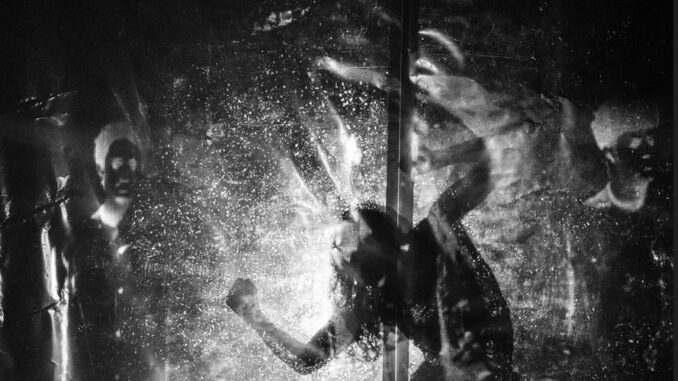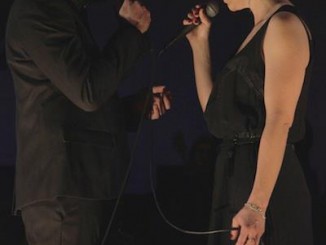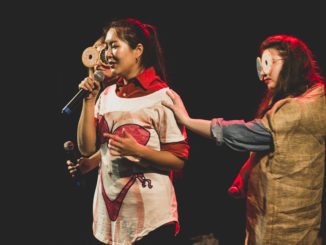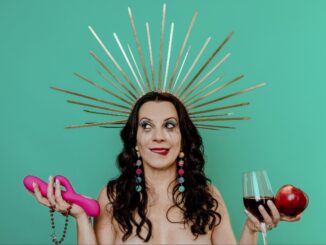
[Dream Sleep]
Moe Miti, presented by Red Leap Theatre, beautifully conjures a liminal space – not quite real, not quite unreal – and explores within it the complex relationship one has to one’s past and identity. It manages to tell a nuanced and unique story about intergenerational trauma with very little narrative. It is at once specific and universal. Director Katrina George has crafted a work that is deeply Sāmoan, but still tangibly relatable to a Pākehā like myself.
Horror is cleverly used throughout Moe Miti, making visceral and palpable the feelings of trauma and rage before the rational mind has time to decipher that this is what the show is about. Jane Hakaraia’s lighting works harmoniously with Owen McCarthy’s incredible spatial and AV design to create the dreamlike space evoked by the title; ‘Moe Miti’ which means ‘dream sleep’ (from what I can gather). Perhaps a sleep that is disturbed by dreams – a place where ghosts of the past hide in shadows, where time itself has no meaning.
Large sheets of something resembling tin foil make up the backdrop and wings in Q Theatre’s Loft. The lights bounce off them, creating a startling shimmering effect, like the sun on the ocean. A tube feeds into a white, plastic oblong on the floor, slowly filling it until it looks like a cloud. Soon, this will become the womb and umbilical cord from which our protagonist will be ripped. Pepe (Malama Tila) emerges in darkness. She is always searching for connection – for some ‘other’ in which to see herself, but particularly for the comforting embrace of her mother. But the umbilical cord, once severed, cannot be put back; it snakes away from her into the darkness. Right from the start, there is a sense of traumatic disconnection.
Soon we are introduced to her mother, Valu (played with vigour and depth by Katerina Fatupaito), in a (refreshingly welcome) comedic sequence. Although she is steeped in Sāmoan culture and modes of behaviour, she is a deeply recognisable figure: the mother not yet ready to let go of her youth, whose daughter is only a reminder of her age. Or perhaps it is Pepe’s lack of understanding that irks Valu so much – her connection to the modern, the western. Valu’s own connection to the ancestor, Aiga (Ma’aola Faasavala), is sacred and yet full of darkness, trapping her in modes of toxicity and anger. Aiga herself is an elusive figure, the often evil-seeming spectre that haunts the piece, but who, god-like, seems to defy definition.
The three feminine figures represent the past, the present and the future. The past looms large over the dream-space yet is rarely directly accessible. Pepe, in particular, is cut off from the past (Aiga) for most of the piece. Valu, as the present, must bear the burden of carrying the past. Aiga is raw with a kind of demonic rage, perhaps with the trauma of colonialism. It is through Valu that this rage manifests until it becomes a cycle that threatens to trap Pepe too. The three performers are electric together, their physicality strong and fluid. They manage to hold a lightness, even as they explore the depths of anger, darkness, and despair.
The reflective sheets, evocative of the sea, are perfect for a piece about island culture. But, like almost everything else in this show, their symbolic meaning is slippery, ghostlike – containing multitudes. Sometimes it is the sun on the ocean, sometimes the moon. Sometimes it is the darkness of disconnection, aloneness – reflecting only your own image back. Sometimes it reflects the past, the faces of your ancestors. Sometimes it inexplicably reveals a performer behind it, becoming a window into the realm of spirits and dreams.
At the centre of the backdrop is a tall, transparent box which moves forward on a rig almost to the front of the stage. This piece of staging is so simple but so effective. It creates the realm of the past – visible, close enough to touch, and yet clearly delineated, not quite available. Purple laser beams refract through it like the light of stars – ancient, yet persisting into the now. It is the space of the ancestor, Aiga. And, just like her, it is sometimes a force of darkness, a place where Valu and Pepe eventually become trapped, held within patterns of fear and rage. Moe Miti explores a complex relationship to the past, the way it can both nourish and bind, and the box is the physical manifestation of this.
Eventually, the three figures are able to break out of the box, led by Pepe. This ending is tentatively hopeful – the sudden wash of light is stark, almost exposing, after being so long in the dark. But as the three begin to sing together, there is a sense, finally, of love and connection.
There is so much meaning to be mined from this rich and evocative piece. It is a beautiful weaving together of stories, symbols and modes that will be particularly resonant with Pasifika audience members but is universally accessible. It deftly integrates its innovative tech and design elements with physicality and text. It is primal and emotive and magnetic – a dazzling, electrifying piece that I certainly hope has a bright future ahead.
Moe Miti plays Q Theatre Loft 22nd-27th August 2023




Leave a Reply